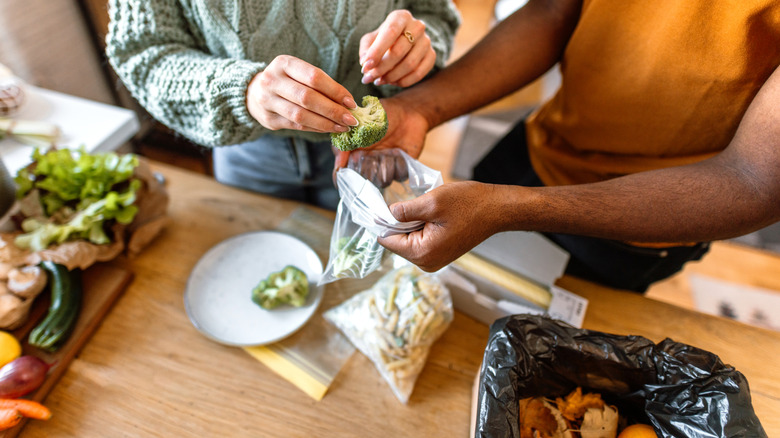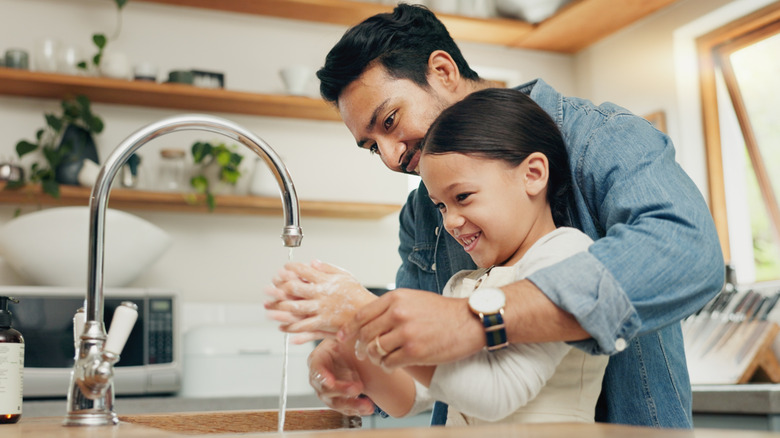What To Consider Before Reusing A Plastic Bag, According To Science
Plastic is versatile and convenient to use, but it's not exactly eco-friendly. One look at the floating island of plastic in the Pacific Ocean would tell you all you need to know about the unexpected way plastics are harming our oceans (and health). According to a 2022 review in Ecotoxicology and Environmental Safety, 79% of plastics wind up in garbage dumps. With this in mind, you might feel like it's more responsible to reuse your disposable plastic sandwich and storage bags. And it can be, as long as you follow some steps to determine if each of your used plastic bags is worth saving or if it's reached the end of its usefulness.
After all, plastic may be strong and flexible, but it isn't indestructible. In a Real Simple interview, food scientist Jessica Gavin explained that most of the plastic bags for food are "made from thin polyethylene," which "can develop cracks over time." She added that because they break down, most bags can only be used a couple of times.
Still, getting two or three times the mileage from any plastic product allows you to live greener as well as stretch your food storage budget. And it's not difficult to determine if the bag in your hand deserves another try.
Initially evaluating a used plastic bag
First, consider what was in the bag. For instance, did you store dry snacks like crackers? In that case, it's probably okay to give it a second chance. The only exception to this rule is if the plastic bag carried a food that's an allergen to someone in your household, in which case it could be tricky to properly clean it out to avoid the possibility of cross-contamination. What if your plastic bag contained raw meat, fish, or poultry? As you might suspect, it's meant for recycling and not reusing. It's just too risky to potentially introduce lingering bacteria to other foods. (Here's what you should do to avoid getting salmonella from beef.)
Remember: Bacteria can be very sneaky. In 2012, NBC reported on the findings from a 2010 case of food poisoning among soccer players and their families. The illness was traced to a reusable plastic grocery bag that was compromised by someone with norovirus (learn about the causes, symptoms, and treatments for norovirus). Once on the bag, the norovirus hung around and caused quite a bit of discomfort for multiple people. Findings from a 2024 study in the Journal of Hazardous Materials illustrate how quickly germs can grow on plastic. The study determined that E. coli O517 colonies can take hold in a half hour and last for 21 days.
Even if your plastic bags were only filled with greasy foods or staining sauces, you're better off using another bag. Otherwise, you'll have trouble in step two.
Thoroughly scrubbing and sanitizing a plastic bag
Next, clean the plastic bag. And before you ask, yes, it's completely okay. As a Ziploc Food Storage Bags spokesperson told America's Test Kitchen: "I'm happy to share Ziploc Food Storage Bags can be handwashed, rinsed and reused."
According to the representative, the most convenient way to get crumbs and stuck-on food from the inside of the bag is to squeeze a little dish soap and warm water inside the bag. Swish it around a bit, and then discard the dirty water. When you're satisfied with the results, rinse any remaining suds and debris away with clean water. After that, just prop open the bag to allow the interior to air dry. (Be sure it's completely dry before reusing since moisture allows bacteria to breed.) Resist the temptation to turn your plastic bag inside out during this process. You might damage the folds of the bag, which would make it less effective as a sealed container.
The third step is to store your used bag in a way that works for your household. Some methods include reusing the box they came in, storing them flat, or rolling them up. Either way, your bags will be waiting — and you'll feel better about your decision to be good to the planet while maintaining hygienic kitchen protocols.


